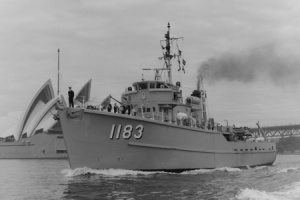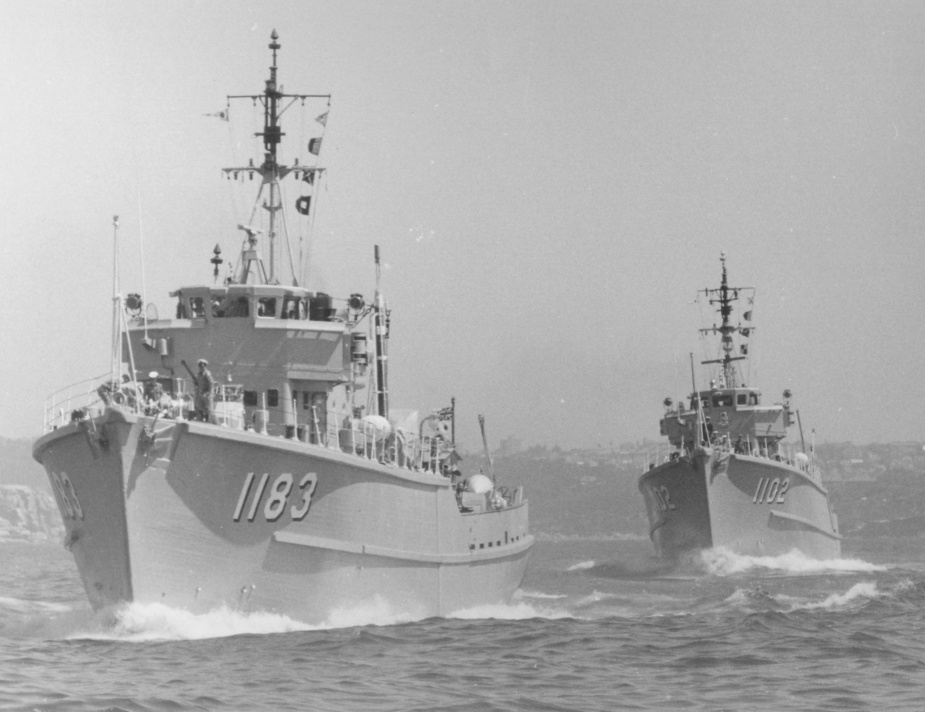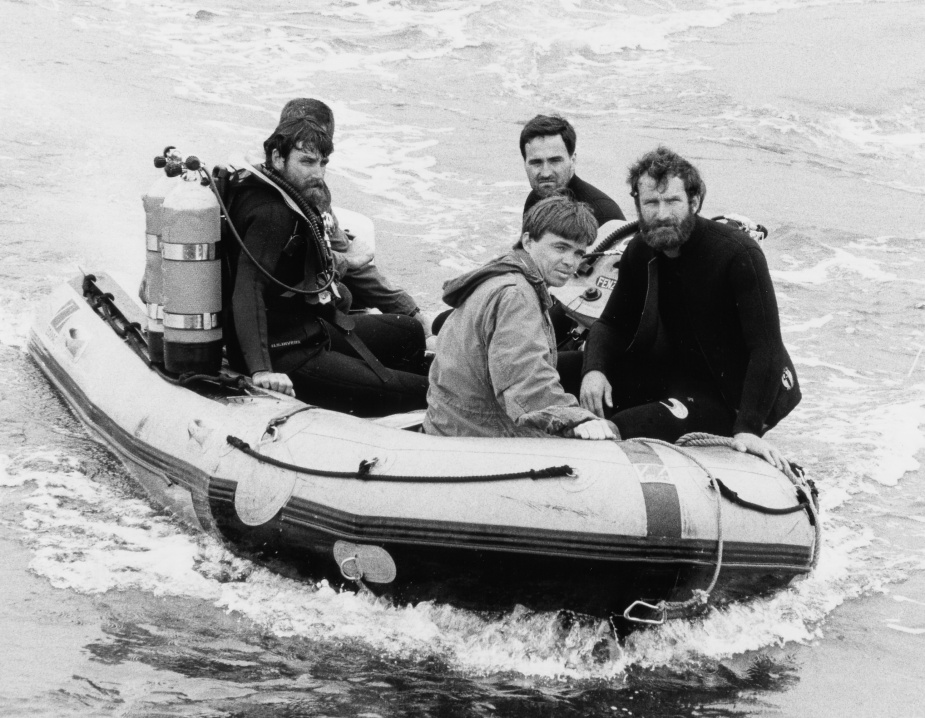HMAS Ibis (II)
| Class |
Ton Class |
|---|---|
| Type |
Minesweeper |
| Pennant |
M1183 |
| Builder |
Montrose Shipyard, Angus, Scotland |
| Laid Down |
15 October 1953 |
| Launched |
19 November 1955 |
| Commissioned |
7 September 1962 |
| Decommissioned |
4 May 1984 |
| Dimensions & Displacement | |
| Displacement |
|
| Length | 46.6 metres (152 feet) |
| Beam | 8.8 metres (29 feet) |
| Draught | 2.5 metres (8 feet) |
| Performance | |
| Speed | 15 knots |
| Complement | |
| Crew | 34 |
| Propulsion | |
| Machinery | 2 Napier Deltic diesels |
| Horsepower | 3000 |
| Armament | |
| Guns | 2 single 40/60 Bofors |
| Awards | |
| Inherited Battle Honours | DARWIN 1942-43 |
| Battle Honours | MALAYSIA 1964-66 |

HMAS Ibis was one of six ex-Royal Navy Ton Class minesweepers acquired by the Royal Australian Navy (RAN). Her sister ships were HMA Ships Hawk, Gull, Snipe, Curlew and Teal. The six Ton Class minesweepers formed the 16th Mine Countermeasures (MCM) Squadron and provided the RAN with the means to gain and maintain proficiency in mine countermeasures.
Following her completion as HMS Singleton on 29 September 1956 she was placed into the Reserve Fleet at Hythe. She was purchased by the RAN in 1961 and commissioned as HMAS Ibis on 7 September 1962, under the command of Lieutenant AL Beaumont, RAN. She arrived in Sydney with her sister ships on 7 December 1962.
Ibis conducted a routine exercise and maintenance programme in Australian waters until Ibis and her sister ships sailed for their first overseas deployment on 20 September 1963 as part of Operation GARDENING, a minesweeping task to clear a channel into Tonolei Harbour in Bougainville, where US aircraft had dropped a large number of magnetic mines in 1943. This was the RAN's biggest minesweeping operation for 16 years. The deployment also included overseas port visits to Singapore and Port Moresby, and the conduct of Hydrographic surveys in the Solomon Sea and Chestnut Bay (125 miles south-east of Port Moresby). The Squadron returned to Sydney that December and Ibis commenced a mid-cycle docking at Garden Island Dockyard.
Ibis had only recommenced routine mine countermeasures exercises early in February 1964 when, from 11-13 February, she was called upon to assist in the search for survivors of the Melbourne/Voyager disaster. Ibis entered refit on 14 May at garden Island to prepare her for her first Far East Strategic Reserve deployment as part of Australia's commitment to Commonwealth support for Malaysia during the Indonesian Confrontation.
Ibis departed Australia for Singapore on 17 August 1964 in company with Teal to relieve Gull and Hawk on patrol duties. During this deployment, the Naval Board decided that, rather than ships wasting time and resources returning to Australia between deployments, the ships would remain on station and crew changes and any necessary maintenance would occur at one of the Royal Navy bases in Singapore or Hong Kong. For Ibis the time spent on patrol in the Far East was tiring, repetitious and uneventful. Ibis and Teal departed Singapore on 16 January 1966 and arrived back in Sydney on 8 February after an absence of some 17 months.
Upon her return, Ibis entered a much-needed refit at Garden Island Dockyard, remaining in dockyard hands until late May 1966, following which she predominantly operated in Australian waters conducting routine mine countermeasures exercises, equipment trials, maintenance and survey work. On 11 October 1967, Ibis, in company with Teal, left Sydney to circumnavigate the country conducting surveys and mine countermeasures exercises. The two ships returned to Sydney on 21 December becoming the first Ton Class ships to circumnavigate Australia.
Both Ibis and Teal were paid off into Operational Reserve on 15 January 1968, due to manpower constraints. On 7 November 1969, however, Ibis recommissioned under the command of Lieutenant Commander CJ Littleton, RAN, with most of the recommissioning crew having been transferred from Gull, which decommissioned on the same day. The ship immediately began storing and maintenance in preparation for her impending South East Asian deployment the following year.
On 30 April 1970, Ibis, in company with Curlew and Teal, departed Sydney for South East Asia. During this deployment she participated in Exercises CRACKSHOT and BERSATU PADU, with more than 30 ships of the Australian, British, Malaysian and New Zealand Navies. Ibis arrived back in Sydney on 27 July and recommenced routine exercises on the east coast of Australia until, on 17 December 1970, she was once again decommissioned into the Reserve Fleet.
On 1 June 1973, after an absence of some two and a half years, Ibis was again recommissioned, this time under the command of Lieutenant Commander RV Morritt, RAN. For the remainder of 1973 and 1974, Ibis operated on the Australian coast conducting maintenance, equipment trials, mine countermeasures exercises, some survey work and participating in Exercise KANGAROO ONE in June 1974.
Ibis deployed to Papua New Guinea in March 1975 in company with Curlew and Snipe, to contribute to Operation STILL DUSTY to clear mines laid by Australian forces during WWII in Bootless Inlet, near Port Moresby and which now impeded the laying of a submarine telecommunications cable between Port Moresby and Cairns. Post-war minesweeping had rendered the area safe for surface navigation, but not for cable laying or other underwater activities. This was the largest minehunting operation by the RAN to date which involved the detection and clearing of mines from an area of 12 square kilometres by the end of April.
Ibis returned to Australian waters in May 1975 and commenced survey operations, most notably in the approaches to Darwin in the aftermath of Cyclone Tracy. During the month long operation, several sunken trawlers and other navigational hazards were located, most of them victims of the Cyclone, and whose fate had previously been unknown. In early November 1975, Ibis assisted Snipe in recovering a Navy Sea King helicopter that had ditched into the sea in the Shoalhaven Bight. Later that month, Ibis entered a leave and maintenance period.
During the first half of 1976, Ibis operated predominantly in Australian waters, with the exception a deployment to New Zealand in January in company with Snipe. Ibis and Snipe became the first Australian warships to enter Westport Harbour, which had a bar of 2.8 metres, the same as the draught of the MCM vessels. Ibis arrived back in Sydney on 18 February and recommenced routine exercises in East Australian waters until 7 June. The second half of the year was spent in dockyard hands for an Intermediate Docking.
In January 1977, Ibis commenced a four month circumnavigation of Australia in company with Curlew gathering oceanographic data for the RAN Research Laboratory. On her return she entered a leave and maintenance period prior to settling into a routine exercise pattern on the east coast of Australia. This routine was broken only by a short goodwill visit to New Caledonia, in company with Snipe, in October.
Ibis commenced a refit on 9 January 1978 at Garden Island Dockyard until May. For the next two years, Ibis maintained a routine exercise and maintenance programme primarily in Australian waters. This included conducting survey work, sonar searches for remaining wrecks from Cyclone Tracy and mine countermeasures exercises. In October 1978, Ibis participated in Exercise LONGEX 78 in New Zealand waters which included naval units from Australia, New Zealand and the United States; and in October 1979, Ibis participated in Exercise KANGAROO THREE.
In February 1980, Curlew, Ibis and Snipe visited Tasmania to participate in festivities for the Hobart Regatta as well undertaking mine countermeasures exercises including a team sweep along the northern Tasmanian coast. This sweep of 90 miles in 40 hours was the longest sweep attempted since WWII and was a record for RAN Ton Class MCMs. The trio followed this with a South West Pacific deployment from March to June which included visits to Port Moresby, Lombrum, Rabaul, Port Vila, Suva and Noumea, as well as exercises with the Papua New Guinean, Fijian and French navies. Ibis arrived back in Sydney on 6 June 1980.
Ibis departed Sydney in September 1980 to once again circumnavigate Australia. Ibis rendezvoused with the Royal New Zealand Navy (RNZN) survey ship, HMNZS Tui, on the Australian west coast on 16 October to participate in Project AKARANA, a joint RAN/RNZN Oceanographic project. Ibis remained attached to the project until arriving in Darwin on 20 November. She arrived back in Sydney on 4 December and commenced preparations for a refit, which began on 2 January 1981 at Garden Island Dockyard.
On 10 February 1981, Ibis was presented the Kelly Shield for outstanding all-round small ship proficiency during 1980. Ibis undocked on 17 September, in spite of industrial action which threatened to prevent her from doing so, and participated in Exercise KANGAROO 81 in October/November. She ended the year in an assisted maintenance period and acted as Starting Vessel for the Sydney to Hobart Yacht Race on Boxing Day.
During 1982, Ibis conducted sound ranging trials, mine countermeasures exercises and training. For two weeks in June 1982, Ibis participated in Operation ESTES conducting Bass Strait Oil Rig Surveillance patrols when the Fleet Patrol Boat designated for that task, HMAS Fremantle, became unserviceable. The availability of Ibis prevented a major disruption to this strategic task. The patrol was a first for a Ton Class MCM. Ibis underwent another refit from 12 July to 6 December.
Ibis participated in the Fleet Concentration Period in February 1983, followed by Exercise SEA EAGLE 83 in February/ March. Upon completion Ibis and Curlew conducted mine warfare pilot surveys in Australian waters before deploying to South East Asia and conducting the first ever mine countermeasures exercises between Australian and Indonesian forces. The two ships entered Sydney on 22 July 1983 completing their four month deployment.
She participated in the Fleet Concentration Period in August before conducting mine warfare pilot surveys, in company with Curlew, around the East Australian coast. On 16 September 1983, Ibis celebrated her 21st anniversary in service.
Ibis finally decommissioned for the last time on 4 May 1984, leaving Curlew as the sole remaining Ton Class MCM in service in the RAN. Ibis remained in the Reserve Fleet until she was sold in 1985 to be broken up.









